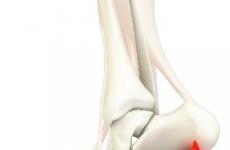Features of the nervous system in children. Myelination of nerve fibers of the optic pathway
Nerve fiber is called the process of a nerve cell, covered with membranes. The central part of any process of a nerve cell (axon or dendrite) is called an axial cylinder. The axial cylinder is located in the axoplasm and consists of the finest fibers - neurofibrils and is covered with a membrane - the axolemma. When examined under an electron microscope, it was found that each neurofibril consists of even thinner fibers of different diameters with a tubular structure. Tubules up to 0.03 µm in diameter are called neurotubules, and up to 0.01 µm in diameter are called neurofilaments. Through neurotubules and neurofilaments, substances are delivered to the nerve endings that are formed in the cell body and serve to transmit a nerve impulse.
The axoplasm contains mitochondria, the number of which is especially large at the endings of the fibers, which is associated with the transfer of excitation from the axon to other cellular structures. There are few ribosomes and RNA in the axoplasm, which explains the low level of metabolism in the nerve fiber.
The axon is covered with a myelin sheath up to the point of its branching at the innervated organ, which is located along the axial cylinder not in a solid line, but in segments 0.5-2 mm long. The space between the segments (1-2 µm) is called the Ranvier intercept. The myelin sheath is formed by Schwann cells by repeatedly wrapping them around an axial cylinder. Each of its segments is formed by one Schwann cell, twisted into a continuous spiral.
In the area of the interceptions of Ranvier, the myelin sheath is absent, and the ends of the Schwann cells are tightly attached to the axolemma. The outer membrane of Schwann cells, which covers myelin, forms the outermost sheath of the nerve fiber, which is called the Schwann sheath or neurilemma. Schwann cells are given special meaning, they are considered companion cells, which additionally provide the metabolism in the nerve fiber. They take part in the regeneration process nerve fibers.
Distinguish between pulp, or myelin, and non-pulp, or myelin-free, nerve fibers. Myelinated fibers include somatic nervous system and some fibers of the autonomic nervous system. Non-fleshy fibers are distinguished by the fact that the myelin sheath does not develop in them and their axial cylinders are covered only by Schwann cells (Schwann's sheath). These include most of the fibers of the autonomic nervous system.
^ Properties of nerve fibers ... In the body, excitement is carried out along the nerves, which include a large number of different in structure and function of nerve fibers.
The main properties of nerve fibers are as follows: communication with the cell body, high excitability and lability, low metabolic rate, relative fatigue, high speed of excitation (up to 120 m / s). Myelination of nerve fibers is carried out in a centrifugal direction, retreating several microns from the cell body to the periphery of the nerve fiber. The absence of the myelin sheath limits the functionality of the nerve fiber. Reactions are possible, but they are diffuse and poorly coordinated. As the myelin sheath develops, the excitability of the nerve fiber gradually increases. Earlier than others, peripheral nerves begin to myelinate, then the fibers of the spinal cord, brain stem, cerebellum, and later - cerebral hemispheres. Myelination of the spinal and cranial nerves begins in the fourth month of intrauterine development. Motor fibers are covered with myelin at the time of birth. Most mixed and centripetal nerves myelinate by three months after birth, some by three. The pathways of the spinal cord are well developed at the time of birth and almost all are myelinated. Only the pyramidal tract myelination does not end. The rate of myelination of the cranial nerves is different; most of them are myelinated by 1.5-2 years. Myelination of the nerve fibers of the brain begins in the prenatal period of development and ends after birth. Despite the fact that by the age of three the myelination of the nerve fibers generally ends, the growth in length of the myelin sheath and the axial cylinder continues after the age of three.
^
2.5. Synapse structure. Excitation transfer mechanism
in synapses
The synapse consists of the presynaptic and postsynaptic divisions, between which there is small space, called the synoptic gap (Fig. 4).
^ Rice. 4. Interneuronal synapse:
1 - axon; 2 - synaptic vesicles; 3 - synaptic cleft;
4 - chemoreceptors of the postsynaptic membrane; 5 - the posynaptic membrane; 6 - synaptic plaque; 7 - mitochondria
Thanks to the electron microscopic research technique, synaptic contacts between various formations of neurons were found. Synapses formed by the axon and the body (soma) of the cell are called axosomatic, axon and dendrite axodendritic. Recently, contacts between the axons of two neurons have been studied - they are called axo-axonal synapses. Accordingly, the contacts between the dendrites of two neurons are called dendro-dendritic synapses.
The synapses between the end of the axon and the innervated organ (muscle) are called neuromuscular synapses or end plates. The presynaptic part of the synapse is represented by the terminal branch of the axon, which loses the myelin sheath at a distance of 200-300 microns from the contact. The presynaptic section of the synapse contains a large number of mitochondria and vesicles (vesicles), rounded or oval in size from 0.02 to 0.05 microns. The vesicles contain a substance that facilitates the transfer of excitation from one neuron to another, which is called a transmitter. Vesicles are concentrated along the surface of the presynaptic fiber opposite the synaptic cleft, the width of which is 0.0012-0.03 microns. The postsynaptic part of the synapse is formed by the membrane of the cell soma or its processes, and in the end plate - by the membrane of the muscle fiber. Presynaptic and postsynaptic membranes have specific features structures associated with the transfer of excitation: they are somewhat thickened (their diameter is about 0.005 microns). The length of these sections is 150-450 microns. The thickenings can be continuous and intermittent. The postsynaptic membrane at some synapses is folded, which increases the surface of its contact with the transmitter. Axo-axonal synapses have a structure similar to axo-dendritic ones, in them vesicles are located mainly on one (presynaptic) side.
^ Mechanism of transmission of excitation in the end plate. At present, a lot of evidence has been presented for the chemical nature of impulse transmission and a number of mediators have been studied, that is, substances that contribute to the transmission of excitation from a nerve to a working organ or from one nerve cell to another.
In the neuromuscular synapses, in the synapses of the parasympathetic nervous system, in the ganglia of the sympathetic nervous system, in a number of synapses of the central nervous system, acetylcholine is the mediator. These synapses are called cholinergic.
Found synapses in which the transmitter of excitement is an adrenaline-like substance; they are called adrenalegic. Other mediators have also been identified: gamma-aminobutyric acid (GABA), glutamic acid, etc.
First of all, the conduction of excitation in the end plate was studied, since it is more accessible for research. Subsequent experiments have established that similar processes are carried out in the synapses of the central nervous system. During the onset of excitation in the presynaptic part of the synapse, the number of vesicles and the speed of their movement increase. Accordingly, the amount of acetylcholine and the enzyme choline acetylase, which promotes its formation, increases. When a nerve is irritated in the presynaptic part of the synapse, from 250 to 500 vesicles are simultaneously destroyed, respectively, the same amount of acetylcholine quanta is released into the synaptic cleft. This is due to the influence of calcium ions. Its amount in the external environment (from the side of the fissure) is 1000 times greater than inside the presynaptic part of the synapse. During depolarization, the permeability of the presynaptic membrane for calcium ions increases. They enter the presynaptic ending and facilitate the opening of the vesicles, providing the release of acetylcholine into the synaptic cleft.
The released acetylcholine diffuses to the postsynaptic membrane and acts on areas that are especially sensitive to it - cholinergic receptors, causing excitation in the postsynaptic membrane. It takes about 0.5 m / s to conduct excitation through the synaptic cleft. This time is called synaptic delay. It is composed of the time during which the release of acetylcholine occurs, its diffusion from the presynaptic membrane
to postsynaptic and effects on cholinergic receptors. As a result of the action of acetylcholine on cholinergic receptors, the pores of the postsynaptic membrane open (the membrane loosens and becomes a short time permeable to all ions). In this case, depolarization occurs in the postsynaptic membrane. One quantum of the mediator is enough to weakly depolarize the membrane and cause a potential with an amplitude of 0.5 mV. This potential is called the miniature endplate potential (MEPP). With the simultaneous release of 250-500 quanta of acetylcholine, i.e. 2.5-5 million molecules, the maximum increase in the number of miniature potentials occurs.
MYELINIZATION(Greek myelos bone marrow) - the process of the formation of myelin sheaths around the processes nerve cells during the period of their maturation both in ontogenesis and during regeneration.
The myelin sheaths act as an insulator for the axial cylinder. The conduction speed through myelinated fibers is higher than in unmyelinated fibers of the same diameter.
The first signs of M. of nerve fibers in humans appear in the spinal cord in prenatal ontogenesis at the 5-6th month. Then the number of myelinated fibers slowly increases, while M. in various functional systems occurs not simultaneously, but in a certain sequence in accordance with the time of the beginning of the functioning of these systems. By the time of birth, a noticeable number of myelinated fibers are found in the spinal cord and brainstem; however, the main pathways are myelinated in postnatal ontogenesis, in children aged 1–2 years. In particular, the pyramidal pathway is myelinated mainly after birth. M. of the conducting paths ends by the age of 7-10. The fibers of the forebrain associative pathways are myelinated most recently; in the cerebral cortex of a newborn, there are only single myelinated fibers. Completion of M. indicates the functional maturity of a particular system of the brain.
Usually, axons are surrounded by myelin sheaths, less often - dendrites (myelin sheaths around the bodies of nerve cells are found as an exception). In light-optical examination, myelin sheaths are revealed as homogeneous tubes around the axon, in electron microscopic examination - as periodically alternating electron-dense lines 2.5-3 nm thick, spaced from each other at a distance of approx. 9.0 nm (Fig. 1).
Myelin sheaths are an ordered system of lipoprotein layers, each of which corresponds to the structure of the cell membrane.

In peripheral nerves, the myelin sheath is formed by the membranes of lemmocytes, and in c. n. S. - membranes of oligodendrogliocytes. The myelin sheath consists of separate segments, which are separated by bridges, the so-called. interceptions of nodes (interceptions of Ranvier). The mechanisms of formation of the myelin sheath are as follows. The myelinating axon first plunges into a longitudinal depression on the surface of the lemmocyte (or oligodendrogliocyte). As the axon plunges into the axoplasm of the lemmocyte, the edges of the groove, in which it is located, approach, and then close, forming a mesaxon (Fig. 2). It is believed that the formation of layers of the myelin sheath occurs due to the spiral rotation of the axon around its axis or rotation of the lemmocyte around the axon.
In c. n. with. the main mechanism of the formation of the myelin sheath is the increase in the length of the membranes when they "slide" relative to each other. The first layers are relatively loose and contain a significant amount of cytoplasm of lemmocytes (or oligodendrogliocytes). As the myelin sheath forms, the amount of lemmocyte axoplasm inside the layers of the myelin sheath decreases and eventually disappears completely, as a result of which the axoplasmic surfaces of the membranes of adjacent layers close and the main electron-dense line of the myelin sheath is formed. External sections merged during the formation of the mezaxon cell membranes lemmocytes form a thinner and less pronounced intermediate line of the myelin sheath. After the myelin sheath has formed, the outer mezaxon can be distinguished in it, that is, the fused membranes of the lemmocyte, passing into last layer the myelin sheath, and the internal mesaxon, i.e., the fused membranes of the lemmocyte, directly surrounding the axon and passing into the first layer of the myelin sheath. Further development or maturation of the formed myelin sheath consists in increasing its thickness and the number of myelin layers.
Bibliography: Borovyagin V. L. On the question of myelination of the peripheral nervous system of amphibians, Dokl. USSR Academy of Sciences, vol. 133, no. 1, p. 214, 1960; Markov DA and Pashkovskaya MI Electron microscopic studies at demyelinating diseases of the nervous system, Minsk, 1979; Bunge M. V., Bunge R. R. a. Ris H. Ultrastructural study of remyelination in an experimental lesion in adult cat spinal cord, J. biophys, biochem. Cytol., V. 10, p. 67, 1961; G e r e n B. B. The formation from the Schwann cell surface of myelin in the peripheral nerves of chick embryos, Exp. Cell. Res., V. 7, p. 558, 1954.
H. H. Bogolepov.
Individual neurons are usually combined into bundles - nerves, and the axons themselves in these bundles are called nerve fibers. Nature has taken care that the fibers do the best possible with the function of conducting excitation in the form of action potentials. For this purpose, individual (axons of individual neurons) have special covers made of a good electrical insulator (see Fig. 2.3). The cover is interrupted approximately every 0.5-1.5 mm; this is due to the fact that individual parts of the cover are formed as a result of the fact that special cells at a very early period of development of the body (mainly before birth) envelop small areas axon. In fig. 2.9 shows how this happens. In the peripheral nerves, myelin is produced by cells called Schwannovsky, and in the head it is due to oligodendroglial cells.
This process is called myelination, as the result is a sheath of myelin substance, which is about 2/3 of fat and is a good electrical insulator. Researchers give a very great importance the process of myelination in brain development.
It is known that in a newborn baby, approximately 2/3 of the brain fibers are myelinated. By about 12 years of age, the next stage of myelination is completed. This corresponds to the fact that the child is already developing a function, he is in control of himself quite well. At the same time, the process of myelination ends completely only at the end of puberty. Thus, the process of myelination is an indicator of the maturation of a number of mental functions. At the same time, human diseases are known that are associated with demyelination of nerve fibers, which is accompanied by severe suffering. The most famous is. This disease develops imperceptibly and very slowly, the consequence is movement paralysis.
Why is myelination of nerve fibers so important? It turns out that myelinated fibers conduct excitation hundreds of times faster than unmyelinated ones, that is, the neural networks of our brain can work at a higher speed, which means more efficiently. Therefore, only the thinnest fibers (less than 1 micron in diameter) are not myelinated in our body, which conduct excitation to the slowly working organs of the intestine, bladder and others. As a rule, fibers conducting information about temperature are not myelinated.
How does excitement propagate along the nerve fiber? Let us first examine the case of an unmyelinated nerve fiber. In fig. 2.10 shows a diagram of a nerve fiber. The excited section of the axon is characterized by the fact that the membrane facing the axoplasm is positively charged relative to the extracellular environment. Unexcited (resting) sections of the fiber membrane are negative internally. A potential difference arises between the excited and unexcited sections of the membrane and a current begins to flow. In the figure, this is reflected by streamlines crossing the membrane from the side of the axoplasm, the outgoing current that depolarizes the adjacent unexcited portion of the fiber. Excitation moves along the fiber in only one direction (shown by an arrow) and cannot go in the other direction, since after excitation of a section of the fiber, refractoriness - non-excitability zone. We already know that depolarization leads to the opening of voltage-gated sodium channels and in the adjacent section of the membrane develops. Then the sodium channel is inactivated and closed, which leads to the non-excitability zone of the fiber. This sequence of events is repeated for each adjacent fiber section. Every such excitement is wasted certain time... Special studies have shown that excitation rate unmyelinated fibers is proportional to their diameter: than larger diameter, the higher the speed of the impulses. For example, unmyelinated fibers, conducting excitation at a speed of 100 - 120 m / s, should have a diameter of about 1000 microns (1 mm).
In mammals, nature has kept unmyelinated only those excitement about pain, temperature, control slowly working internal organs urinary fibers, which are carried by organs - the bladder, intestines, etc. Almost all nerve fibers in a person have myelin sheaths. In fig. 2.11 shows that if the passage of excitation is recorded along the fiber covered with myelin, then the action potential arises only in the interceptions of Ranvier. It turns out that myelin, being a good electrical insulator, does not allow the output of streamlines from the previous excited area. The current output in this case is possible only through those sections of the membrane that are at the junction between two sections of myelin. Recall that each site is formed by only one cell, so these are the junctions between two cells that form adjacent areas of the myelin sheath. The axon membrane between two adjacent myelin sheaths is not covered by myelin (the so-called interception of Ranvier). Thanks to this arrangement, the fiber membrane is excited only at the sites of Ranvier's interceptions. As a result, the action potential (excitation), as it were, jumps over the sections of the isolated membrane. In other words, excitation moves in jumps from interception to interception. It is similar to those magic boots-runners, which the cat put on in the famous fairy tale, instantly transported from one place to another.
This process proceeds in pathogenesis sequentially and orderly in strict accordance with embryonic, anatomical and functional features systems of nerve fibers.
Myelin is a collection of lipoid and protein substances that make up the inner layer of the nerve fiber sheath. Thus, the myelin sheath is interior the glial sheath of the nerve fiber, which contains myelin. Myelin sheath is a protein-lipid membrane, which consists of a bimolecular lipid layer located between two monomolecular layers of protein substances.
The myelin sheath is repeatedly twisted in several layers around the nerve fiber. With an increase in the diameter of the nerve fiber, the number of turns of the myelin sheath increases. The myelin sheath is, as it were, an insulating coating for bioelectric impulses that arise in neurons upon excitation. It provides faster conduction of bioelectric impulses along nerve fibers. This is facilitated by the so-called interceptions of Ranvier. Ranvier's interceptions are small lumens of the nerve fiber that are not covered by the myelin sheath. In the central nervous system, these interceptions are located approximately 1 mm apart.
Myelin in the central nervous system is synthesized by oligodendrocytes. One oligodendrocyte synthesizes myelin for about 50 nerve fibers. In this case, only a narrow process of the oligodendrocyte is adjacent to each axon.
In the process of spiral twisting of the shell, a lamellar structure of myelin is formed, while two hydrophilic layers of the surface proteins of myelin merge, a hydrophobic layer of lipids is formed between them. The distance between myelin plates is on average 12 nm. Currently, more than 20 types of myelin proteins have been described. The structure and biochemical composition of myelin in the central nervous system have been studied in detail. Myelin, in addition to the protective, structural and insulator functions, is also involved in the nutrition of the nerve fiber. Damage to the myelin sheath of nerve fibers - demyelination - occurs in various serious diseases, such as encephalomyelitis of various origins, AIDS, multiple sclerosis, Behcet's disease, Sjogren's syndrome, etc.
(module diret4)
Myelination of the distal part (at the posterior pole of the eye) of the optic nerve begins only after the birth of the child. It occurs in the period from 3 weeks to several months, already during the period of intrauterine life. This is the so-called conditionally "cable period", when the entire complex of axial cylinders - axons of retinal ganglion cells is devoid of myelin sheaths and is enclosed in one common membrane. At the same time, the function of conducting visual impulses is preserved, but it is very imperfect and has a diffuse character. Also, "cable nerves" conduct visual impulses by generalization or by transverse induction. In them, the transition of excitation from one fiber without the myelin sheath occurs to another, the same fiber in contact. Such conduction of impulses makes it impossible for them to pass from certain points of the retina to certain zones of the cortical analyzers. Thus, during this period of the child's life there is still no clear retinotopic nature of representation in the visual centers. The nerve fibers of the intracranial part of the optic nerve are covered with the myelin sheath earlier - by the 8th month of intraocular development.
Myelination of the nerve fibers of the chiasm and the optic tracts in newborns is already well pronounced. In this case, myelination spreads to the optic nerve from the center to the periphery, that is, it occurs in the opposite direction of the growth of its nerve fibers. Myelination of the nerve fibers of the brain begins from the 36th week of the embryonic period.
By the time of birth, myelination of the visual pathways in the area of the primary projection cortical visual centers (field 17 according to Brodman) ends. Fields 18 and 19 according to Brodman - continue myelination for another 1-1.5 months after birth. Lately, the fields in the area of the higher associative centers (terminal zones of Fleksig) are myelinated. In these zones, the myelination of the intracerebral conductors, which connect the visual centers of various levels with each other and with the cortical centers of other analyzers, is completed only at the 4th month of the child's life. The axons of some large pyramidal cells in the 5th layer of the Brodmann field 17 begin to be covered with myelin sheath from 3 months of age. In the axons of the cells of the 3rd layer at this age there are still no traces of myelin.
Thus, myelination of the optic pathway nerve fibers begins at the 36th week of the embryonic period and generally ends in the cortical structures of the brain by the age of 4 years.
The myelination of the nerve fibers of the visual pathway is significantly stimulated by light rays. This phenomenon, discovered by Fleksig more than 100 years ago, was later confirmed in a number of scientific publications.






